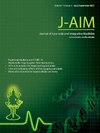Ayurvedic management of hydatid cyst of lungs: A case report
IF 1.7
Q3 INTEGRATIVE & COMPLEMENTARY MEDICINE
引用次数: 0
Abstract
Cystic echinococcosis (CE), which is present in all parts of the world, is caused by the bacterium Echinococcus granulosus. One of the most serious parasitic infectious diseases affecting both humans and animals, CE causes hydatid cysts that can lodge in various host organs, including the liver, lungs, heart, and brain, which can be fatal. Treatment options for cystic echinococcosis are active anthelmintics, surgery, and percutaneous aspiration. Numerous scolicidal chemical agents are in practice, but due to increased drug resistance and adverse reactions associated with drugs, usage is limited. Finding alternative therapies with the least or no side effects to manage the condition is the need of the hour. Here, we report a case of an asymptomatic hydatid lung cyst that was managed using Ayurvedic treatment principles. A 57-year-old businessman, asymptomatic, came with a diagnosis of Hydatid lung disease confirmed by CT scan. Surgery was advised, but the patient approached for Ayurveda treatment. The case was treated with oral medicines like Arogyavardhini gutika, Goarka, Kanchanara guggulu, Vidangasava, Kapalabhati pranayama for a period of 8 months. Complete resolution of the cyst was seen, which was evident by a CT scan. Promising results were seen in the present case, but further research in this area is required to produce evidence-based results.
阿育吠陀疗法治疗肺水瘤囊肿:病例报告
囊性棘球蚴病(CE)存在于世界各地,是由颗粒棘球蚴细菌引起的。囊性棘球蚴病是影响人类和动物的最严重的寄生虫传染病之一,它导致的包虫囊肿可寄生在宿主的各种器官中,包括肝脏、肺部、心脏和大脑,可导致死亡。囊性棘球蚴病的治疗方法有活性驱虫药、手术和经皮抽吸。目前使用的杀虫化学制剂很多,但由于耐药性和药物不良反应的增加,使用受到限制。寻找副作用小或无副作用的替代疗法来控制病情是当务之急。在此,我们报告了一例采用阿育吠陀治疗原则治疗的无症状肺包虫囊肿病例。一名无症状的 57 岁商人经 CT 扫描确诊为肺包虫病。医生建议进行手术治疗,但患者要求接受阿育吠陀治疗。患者接受了为期 8 个月的口服药物治疗,如 Arogyavardhini gutika、Goarka、Kanchanara guggulu、Vidangasava 和 Kapalabhati pranayama。CT 扫描显示,囊肿已完全消退。本病例取得了良好的疗效,但还需要在这一领域开展进一步的研究,以取得循证结果。
本文章由计算机程序翻译,如有差异,请以英文原文为准。
求助全文
约1分钟内获得全文
求助全文
来源期刊

Journal of Ayurveda and Integrative Medicine
INTEGRATIVE & COMPLEMENTARY MEDICINE-
CiteScore
4.70
自引率
12.50%
发文量
136
审稿时长
30 weeks
 求助内容:
求助内容: 应助结果提醒方式:
应助结果提醒方式:


